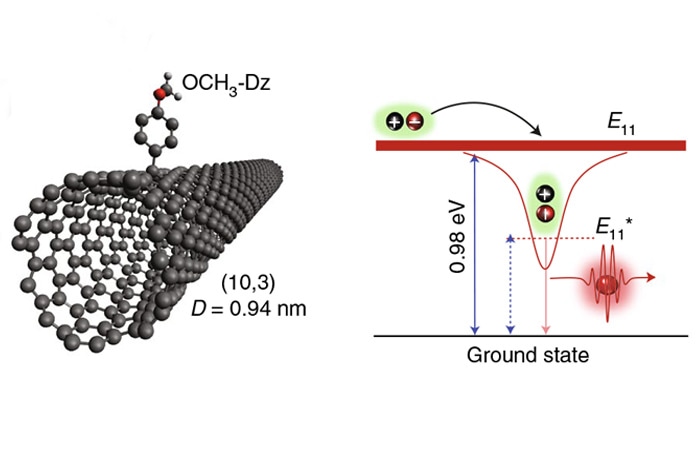Scientists at Los Alamos and partners in Germany and France are investigating the enhanced potential of carbon nanotubes to be used as single-photon emitters in quantum information processing. Their analysis of progress in the field has been reported in the recent edition of the journal Nature Materials.
 Depiction of a carbon nanotube defect site generated by functionalization of a nanotube with a simple organic molecule. Altering the electronic structure at the defect enables room-temperature single photon emission at telecom wavelengths. (Image credit: Los Alamos National Laboratory)
Depiction of a carbon nanotube defect site generated by functionalization of a nanotube with a simple organic molecule. Altering the electronic structure at the defect enables room-temperature single photon emission at telecom wavelengths. (Image credit: Los Alamos National Laboratory)
We are particularly interested in advances in nanotube integration into photonic cavities for manipulating and optimizing light-emission properties. In addition, nanotubes integrated into electroluminescent devices can provide greater control over timing of light emission and they can be feasibly integrated into photonic structures. We are highlighting the development and photophysical probing of carbon nanotube defect states as routes to room-temperature single photon emitters at telecom wavelengths.
Stephen Doorn, one of the authors and a scientist with the Los Alamos National Laboratory site of the Center for Integrated Nanotechnologies (CINT)
The team’s synopsis was produced in partnership with colleagues in Paris (Christophe Voisin) who are progressing the incorporation of nanotubes into photonic cavities for altering their emission rates, and at Karlsruhe (Ralph Krupke) where they are incorporating nanotube-based electroluminescent devices with photonic waveguide structures. The Los Alamos aim is the examination of nanotube defects for pushing quantum emission to telecom wavelengths and room temperature, he stated.
As the paper reveals, “With the advent of high-speed information networks, light has become the main worldwide information carrier. . . . Single-photon sources are a key building block for a variety of technologies, in secure quantum communications metrology or quantum computing schemes.”
The utilization of single-walled carbon nanotubes in this field has been a focus for the Los Alamos CINT team, where they created the ability to chemically alter the nanotube structure to form deliberate defects, localizing excitons, and regulating their release. The following steps, Doorn notes, involve incorporation of the nanotubes into photonic resonators, to provide better source brightness and to produce indistinguishable photons.
“We need to create single photons that are indistinguishable from one another, and that relies on our ability to functionalize tubes that are well-suited for device integration and to minimize environmental interactions with the defect sites,” he said.
“In addition to defining the state of the art, we wanted to highlight where the challenges are for future progress and lay out some of what may be the most promising future directions for moving forward in this area. Ultimately, we hope to draw more researchers into this field,” Doorn said.

